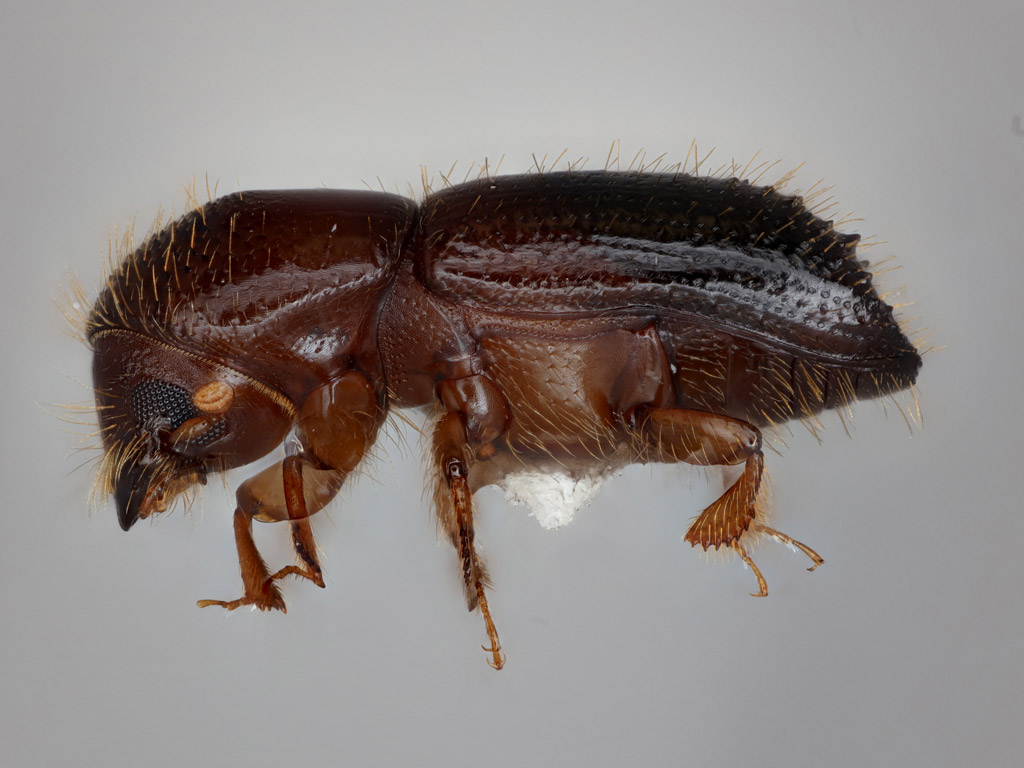Understanding the role of insects in the spread of the fungal disease, Rapid ‘Ōhiʻa Death (ROD), has been a main focus for Kylle Roy prior to beginning her PhD work at Purdue. Her research has found that similar to other Ceratocystis diseases, ROD is associated with wounds and ambrosia beetles. The invasive ambrosia beetle species in the Xyleborini tribe including Xyleborinus saxesenii (Ratzeburg), Xyleborus affinis Eichhoff, Xyleborus ferrugineus (Fabricius), and Xyleborus perforans (Wollaston) are commonly reared from ROD-infected ‘ōhiʻa, and all of the species produce frass containing viable Ceratocystis propagules (Roy et al. 2019; Roy et al. 2020) that can kill ‘ōhiʻa. In addition, Leachʻs Rules for insect transmission of diseases (Leach 1940) have been fulfilled for all four of the beetle species, in a manuscript set to be published in 2023. Therefore, these adventive beetles can transmit ROD-causing fungi both directly on their bodies and indirectly through the frass that they produce; Ceratocystis-contaminated frass can be blown in the wind or spread in the soil. Given the role of these beetle species in the spread of ROD, there is a critical need to develop ambrosia beetle management strategies to mitigate the spread of ROD and protect the Hawaiian rainforest and watershed.

Understanding the chemical ecology of ROD could lead to early detection tools and the development of attractants and repellents to manipulate beetle populations, protecting both healthy and ROD-infected tree stands and individual ʻōhiʻa. Kylle’s PhD work encompasses different aspects of understanding how ‘ōhiʻa trees, ROD-causing fungi (C. lukuohia and C. huliohia), and Xyleborini ambrosia beetles communicate, with the long-term goal of developing management strategies to prevent the spread of ROD.

The first chapter of Kylle’s thesis encompasses the identification of the volatile organic compounds (VOCs) produced by C. lukuohia and C. huliohia in culture, ʻōhiʻa seedlings inoculated with the two fungal pathogens, and the response of the invasive ROD-associated ambrosia beetles to those compounds using still-air olfactometer assays. Results suggest that both ROD-causing fungi produce fruity fusel alcohols and acetates that elicit species-specific responses from the ROD-associated Xyleborini beetles. VOC profiles of C. lukuohia and C. huliohia were nearly identical, except for a pineapple-like compound that was present in C. huliohia and not C. lukuohia. The ambrosia beetles X. ferrugineus and X. affinis responded positively to C. lukuohia volatiles while X. affinis and X. perforans responded positively to C. huliohia. Similar VOCs are produced from C. lukuohia and C. huliohia in culture as well as in inoculated ʻōhiʻa seedlings.

The second and third chapters of Kylleʻs thesis are focused on the development of semiochemical tools to manage ambrosia beetles and the spread of ROD. Along with collaborators at U.S. Geological Survey and Hawaiʻi Cooperative Studies Unit, Kylle tested lures for attracting the ROD-associated ambrosia beetles as well as two different beetle repellents, a verbenone-based repellent in a SPLAT Verb formulation and a verbenone + methyl salicylate repellent called SPLAT Beetle Guard on traps in a 2-year repeated experiment. They found ethanol to be the best attractant for all of the ROD-associated ambrosia beetles and that both repellents were effective at deterring ambrosia beetles from traps equipped with lures. These data provided invaluable information that took the project to the next step and earned a competitive Forest Service Forest Health Protection Special Technology Development Program Grant to test the repellents on both healthy and ROD-infected ʻōhiʻa trees in the field. For this next project, due to registration regulations, only the verbenone-based repellent (SPLAT Verb) was tested on ʻōhiʻa trees on Hawaiʻi Island. A low label application rate and high label application rate were tested for both healthy and ROD-infected ʻōhiʻa trees, and overall, the low application rate was sufficient for reducing beetle attack for all ROD-associated species, although re-application to ROD-infected trees may be necessary for Xi. saxesenii after 8 weeks according to gas-chromatography mass spectrometry (GC-MS) data. This study is scheduled to be repeated in Spring 2023, and the results support the registration of the verbenone product in Hawaiʻi to prevent the spread of ROD.


